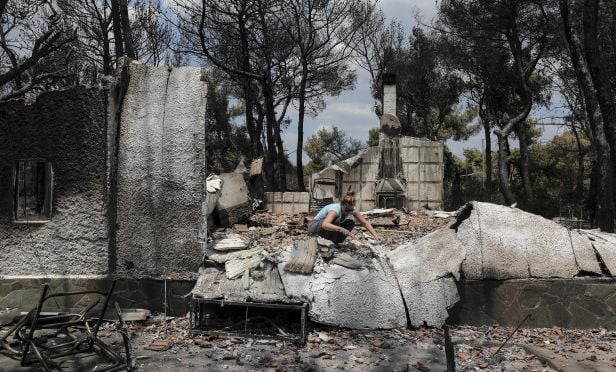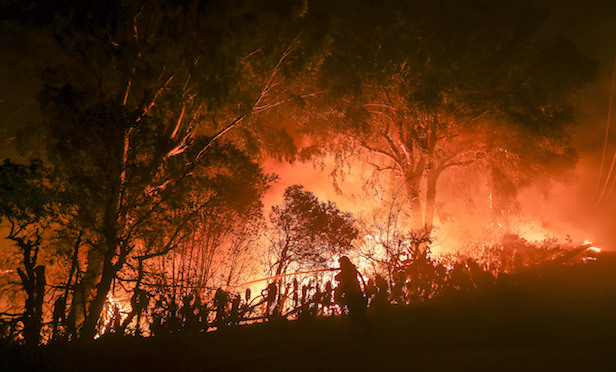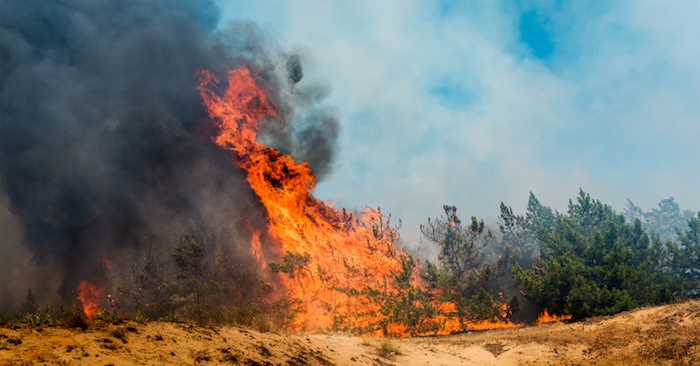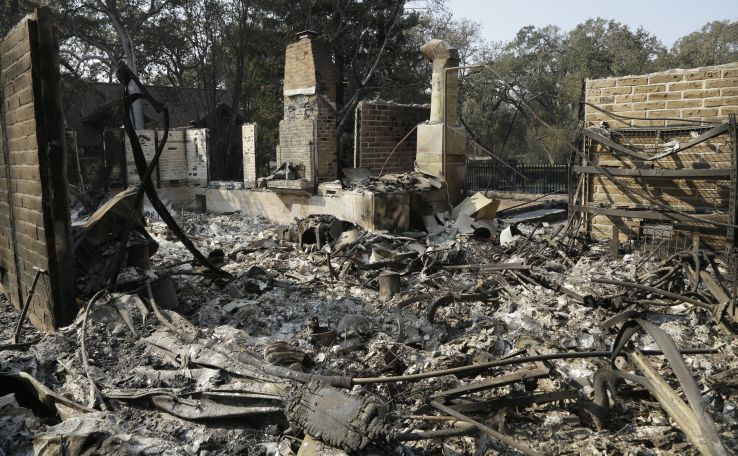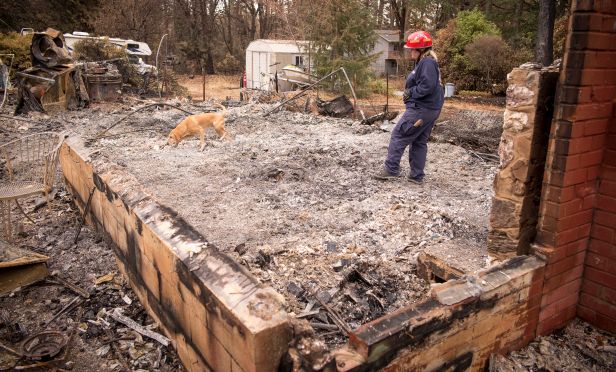 A search and rescue worker walks with a cadaver dog whilelooking for a missing person in Paradise, California, on Monday,Nov. 26, 2018. The nation's deadliest wildfire in a century knownas the Camp Fire killed at least 85 people and burned over 14,000homes. (Photo: David Paul Morris/Bloomberg)
A search and rescue worker walks with a cadaver dog whilelooking for a missing person in Paradise, California, on Monday,Nov. 26, 2018. The nation's deadliest wildfire in a century knownas the Camp Fire killed at least 85 people and burned over 14,000homes. (Photo: David Paul Morris/Bloomberg)
(Bloomberg Opinion) — Own a home? No doubt you've insured it.Very sensible of you. But if that home were, say, burnedto the ground, then your insurance company probably wouldn't coverthe cost of rebuilding it.
|Don't feel too bad, though. It'sonly partly your fault.
|Estimates: 60-80% of policyholders are under-insured
Two-thirds of California wildfire victims areunder-insured, according to Amy Bach, executive director ofconsumer advocacygroup United Policyholders, speaking at a recentmeeting of governor Gavin Newsom's wildfirecommission, held in Santa Rosa. Shocking as that figureseems, it comports with anecdotes I picked up reporting on theaftermath of the recent wildfires earlier this year.Meanwhile, Sarah Paulson of Kevin PaulsonInsurance Agency Inc. in San Diego, estimates maybe 60% ofpolicyholders are under-insured.
|Now a new study titled "Minding the Protection Gap," justpublished in the Connecticut Insurance Law Journal, concludes theprevalence of under-insurance among American homeowners might becloser to 80%.
|Kenneth Klein, a professor at California WesternSchool of Law, bases that estimate partly on a report from theCalifornia Department of Insurance, prepared in the wake of the2007 wildfires, that recently became public record. Remarkably,this found that even when homeowners hadpurchased extended coverage, 57% of such policies fell short.
|Summing up his study over the phone, Klein callshomeowner insurance "a really weird market; people think theybought a Cadillac when they really bought a Yugo."
|Most homeowners think they have adequate coverage
By and large, homeowners think they do have adequatecoverage in the event of a catastrophe — andthat's where they take a share of the blame. Standardpolicies haven't offered "guaranteed replacement coverage" forseveral decades. But unless the homeowner takes the time to readthe mind-numbing policy documents or ask the right questions, theygenerally assume they're good if the sky falls.
|Before piling onto this feckless homeowner, though, ask yourselfa question: Do you know how much it would cost to rebuild yourhome? Didn't think so.
|Most likely, you're relying on an estimate from your insuranceagent. Typically, those are derived from sophisticated softwaretools such as Verisk Analytics Inc.'s 360Value or CoreLogic Inc.'s RCT. Insurance is theoriginal big-data business, compiling myriad items ofinformation to judge probabilities and costs; these tools areimmense databases of such things as local labor rates,materials prices, storage costs and many other line items.
|No software can accurately predict every contingency,though; especially if, for example, a wildfire burns downa whole neighborhood and surge pricing kicks in. More importantly,software doesn't write insurance, companies do. And theincentives in homeowner insurance tend to skew oneway.
|Ignorant of true cost of reconstruction
Only a small proportion of homes are sold each year,capping the size of the market for policies. Customers tend to beignorant of the true cost of reconstruction. And when disputesarise, courts tend to effectively side with the insuranceprovider — after all, the homeowner signed up for thecoverage stipulated in their contract.
|In short, the homeowner tends to bear all the risk ofunder-insurance while usually being ignorant of that risk. Plus,thinking catastrophe a very remote possibility, they're moremotivated to keep their monthly insurance bill low than to curetheir ignorance.
|So there can be little incentive for an insuranceprovider to invest time and money in a more-thoroughassessment of a home's particular risks. It's tempting toinstead enter fewer parameters to the software tools toestimate coverage and simply quote the most competitivepremium they can.
|Klein ran an experiment on his own home, gettingreplacement-cost estimates from six insurers andtwo software tools, involving different levels of detail.They ranged from $512,000 to more than $1.1 million.
|Better-educating the customer
One way of addressing this problem is better-educating thecustomer, such as with tools alerting them to potentialunder-insurance. Meanwhile, Klein recommends requiring insurers toquote a price for guaranteed replacement coverage. Would thosepremiums be higher? Probably much higher, although providers couldalso compete on them.
|More importantly, they would signal to homeowners the true costof protecting their home — and they could then choose toaccept it or go with a lower quote for standard insurance, with theclear understanding they bear the risk of less-than-adequatecoverage. "This will reconnect risk creation and risk allocation,"Klein writes.
|California's wildfires didn't create this market failure; justrevealed it. The enormous claims arising from the past two wildfireseasons — some $25 billion — are having an impacton pricing and availability already. At that samecommission meeting in Santa Rosa, Joel Laucher, chiefdeputy commissioner of the California Department of Insurance,said complaints about higher premiums or difficulty renewingcoverage in the highest-risk counties have jumped by 224% and 573%,respectively, since 2010.
|Meanwhile, over the past five years, there has been a 51%increase in policies written for homes in wildfire-prone areasunder California's FAIR program — insurance sobare-bones the website states up top it should only beused as "a last resort."
|Climate change & people's choices about where to live
In many respects, the wildfires expose thetrue costs of climate change and howthey intersect with people's choices about whereand how they live; choices often made out of necessity or made at atime when phrases like "global warming" seemed utterlyabstract.
|Mitigating wildfire risk is, of course, central to addressingthis, but so is reform of insurance, society's ingeniousmethod of pooling risk. Pushing the industry to provide betterincentives for, say, hardening homes and communities mustbe a priority for California — and, indeed, anyother state facing rising risks from a changing climate. Makingthose risks, and their costs, crystal clear to consumers would be agood start.
|Liam Denning is a Bloomberg Opinion columnist coveringenergy, mining and commodities. He previously was editor of theWall Street Journal's Heard on the Street column and wrote for theFinancial Times' Lex column. He was also an investment banker. Tocontact the author of this story: Liam Denning at [email protected].
|Related:
- The importance of a catastrophereview
- Climate change, insurance gaps away-of-life illusion in Calif. and U.S.
- California works to head off another seasonof deadly fires
Copyright 2019 Bloomberg. All rightsreserved. This material may not be published, broadcast, rewritten,or redistributed.
Want to continue reading?
Become a Free PropertyCasualty360 Digital Reader
Your access to unlimited PropertyCasualty360 content isn’t changing.
Once you are an ALM digital member, you’ll receive:
- All PropertyCasualty360.com news coverage, best practices, and in-depth analysis.
- Educational webcasts, resources from industry leaders, and informative newsletters.
- Other award-winning websites including BenefitsPRO.com and ThinkAdvisor.com.
Already have an account? Sign In



